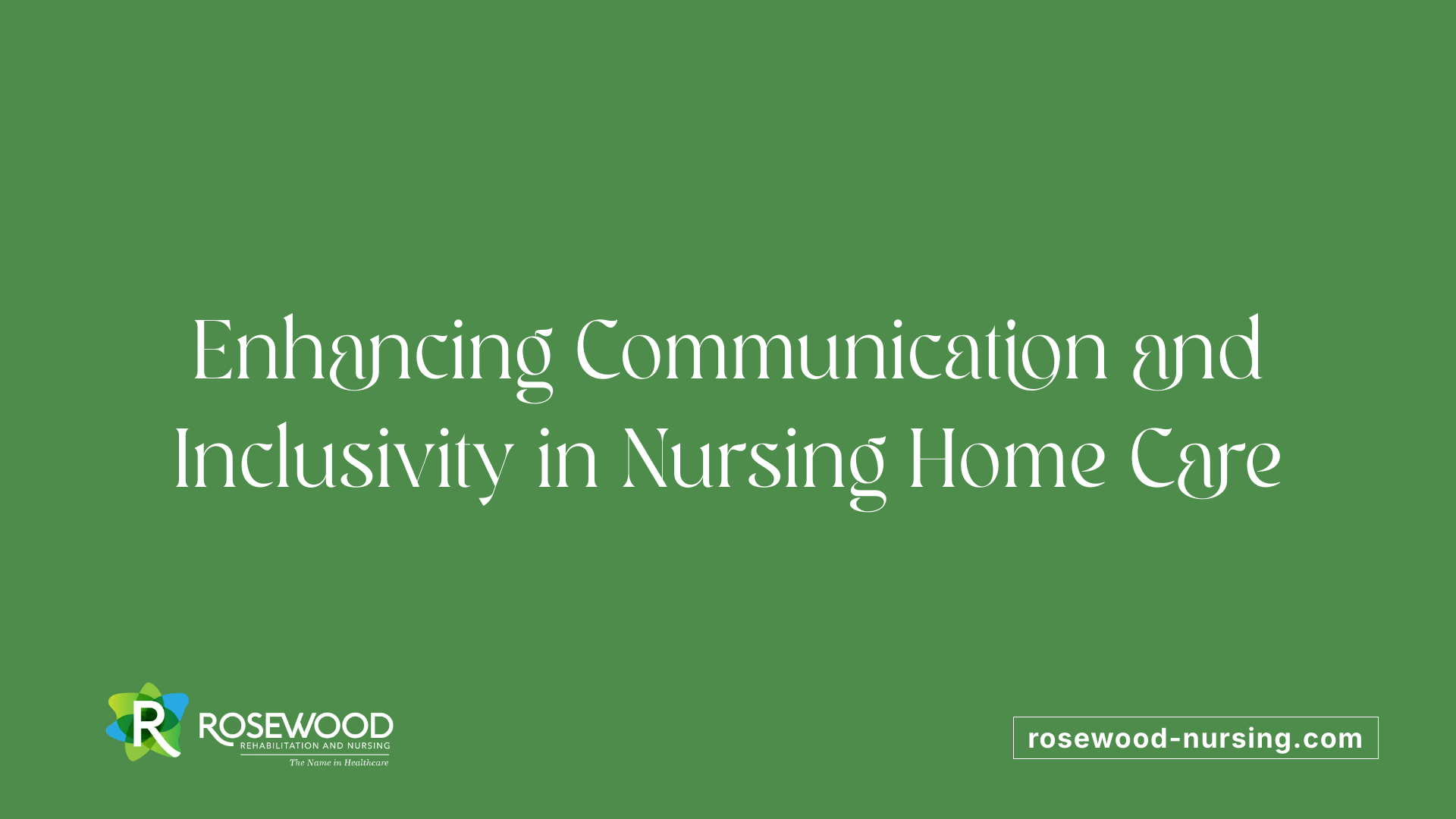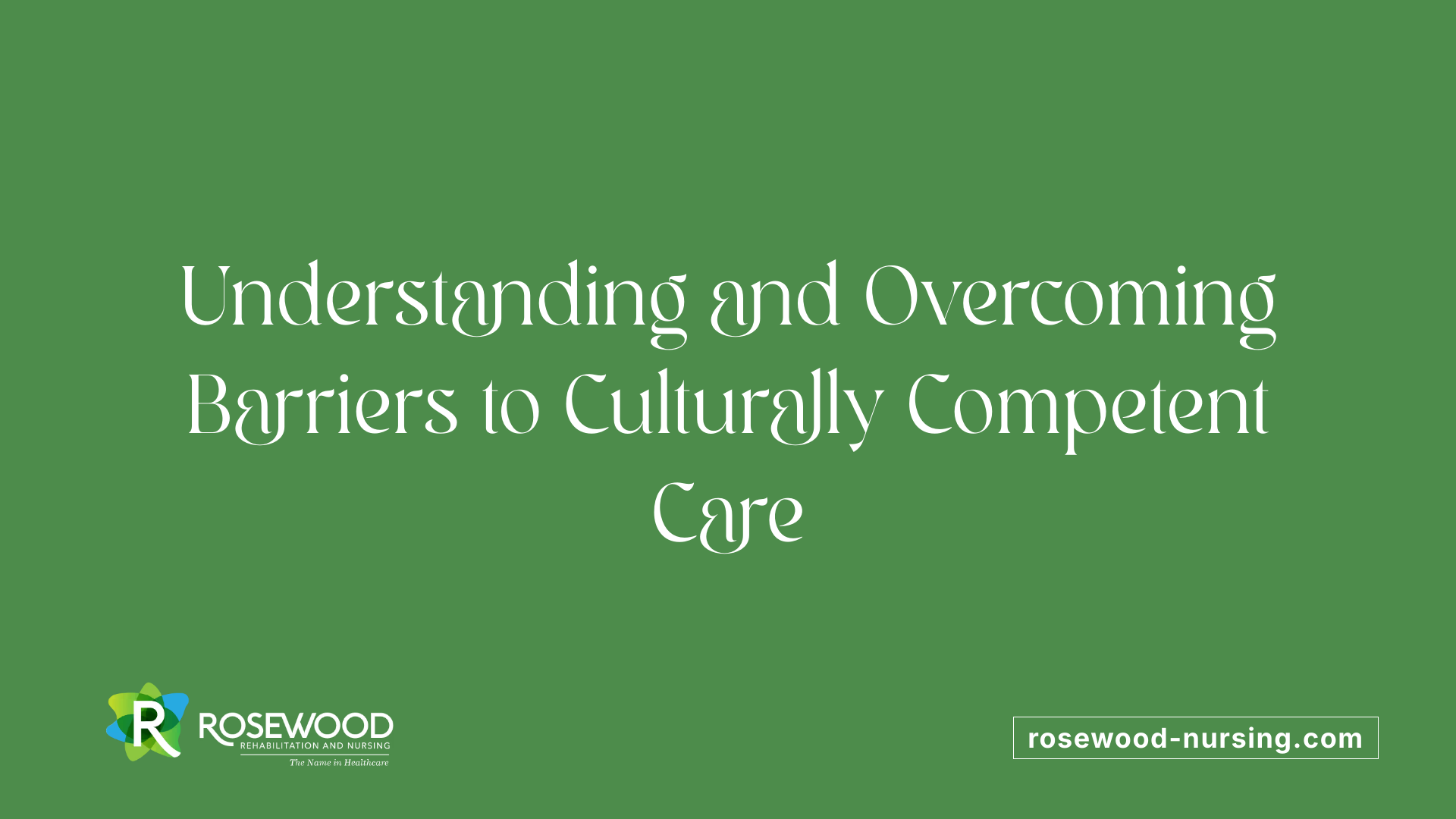How Nursing Homes Adapt to Cultural and Religious Needs
April 7, 2025
Adapting Nursing Homes for Cultural Inclusivity and Spiritual Fulfillment

Introduction to Cultural and Religious Adaptation in Nursing Homes
As the population ages and becomes more diverse, nursing homes face the critical task of adapting to the varied cultural and religious needs of their residents. Cultural competence and sensitivity in nursing care are essential in fostering environments where all individuals feel respected and understood. This article explores the strategies employed by nursing homes to accommodate these diverse needs, the importance of cultural and spiritual inclusivity, and the challenges faced in providing culturally competent care.
Strategies for Accommodating Cultural and Religious Needs
What strategies do nursing homes use to accommodate the diverse cultural and religious needs of residents?
Nursing homes implement a range of strategies to accommodate the diverse cultural and religious needs of residents. One of the primary focuses is enhancing cultural competence among staff, which leads to improved health outcomes and reduced disparities.
Cultural Competence Training
Caregivers undergo training that equips them to understand and respect the diverse backgrounds of residents. This can include learning about different cultural traditions, dietary restrictions, and communication styles. Such training fosters trust and encourages open dialogue between residents and staff.
Ethnic-Specific Food Menus
Many nursing homes offer ethnic-specific food menus tailored to reflect the culinary preferences and dietary laws of their residents. For instance, accommodations for kosher, halal, vegetarian, or vegan diets help maintain the cultural identity of each individual, while also meeting their nutritional needs. Organizing multicultural food festivals can further engage residents in celebrating their heritages.
Spaces for Religious Observance
Creating designated spaces for religious observance is another crucial strategy. Nursing homes often include prayer rooms or areas for specific faith practices, allowing residents to maintain their spiritual routines. Engaging with local religious leaders can also enhance these offerings, ensuring that the spiritual needs of residents are supported effectively.
By addressing language barriers and facilitating effective communication, nursing homes strive to create environments where all residents feel respected and supported in their cultural and religious identities.
Understanding Cultural Competence in Long-Term Care
What is cultural competence in long-term care?
Cultural competence in long-term care refers to the ability of healthcare providers and organizations to deliver services that meet the social, cultural, and linguistic needs of their patients. This capability is crucial, especially as the aging population continues to diversify. It encompasses understanding and respecting various cultural traditions, values, and preferences in care approaches.
Why is cultural competence important for the aging population?
With the expectation that 35% of individuals aged 65 and older will be from diverse backgrounds by 2050, culturally competent care becomes essential for improving health outcomes and addressing disparities in care. Diverse cultural perspectives significantly influence how older adults perceive aging, manage pain, and approach healthcare decisions.
Some challenges these populations face include language barriers and the unavailability of healthcare providers familiar with their cultural backgrounds, which can prevent access to necessary preventive services.
By fostering cultural competence, organizations enhance trust with residents, ultimately leading to better health satisfaction and compliance with treatment options. Institutions such as the National Center for Cultural Competence and the Thrive Center are pivotal in providing resources and training aimed at improving cultural awareness among healthcare providers.
Importance of Cultural Sensitivity in Nursing Homes

Why is cultural sensitivity important in nursing home care?
Cultural sensitivity is vital in nursing homes as it enhances communication and nurtures inclusivity among residents. A respectful and understanding environment allows caregivers to connect meaningfully with residents, which is particularly important given the diversity that populations exhibit today.
By 2050, it is predicted that racial and ethnic minorities will constitute a substantial portion of the older demographic. This shift necessitates that healthcare providers are well-prepared to address the variety of cultural, social, and linguistic needs unique to this population. With these communities often facing elevated rates of chronic conditions and a reported lower satisfaction with healthcare interactions, the importance of culturally competent care becomes even more pronounced.
How does cultural sensitivity affect communication and inclusion?
Addressing language barriers and enhancing health literacy is fundamental in ensuring that older adults fully comprehend their care plans. Effective communication leads to better health outcomes, enabling residents to participate actively in their own care, which contributes to fewer health disparities.
Additionally, cultural sensitivity fosters an atmosphere of trust, allowing for better relationships between residents and caregivers. By respecting individual backgrounds, nursing homes can ensure that all residents receive dignified and personalized care, thereby enhancing their quality of life and emotional well-being.
Demographic projections
The projected demographic shifts underscore the need for nursing homes to adapt their approaches. Preparing for the increasing diversity among older adults will involve training staff in cultural competence, implementing culturally relevant practices, and employing bilingual staff to help bridge communication gaps.
In summary, cultural sensitivity isn't just a best practice in nursing homes; it’s an essential component in delivering high-quality, equitable care that meets the evolving needs of an increasingly diverse resident population.
Addressing Dietary and Spiritual Needs in Nursing Homes

How do nursing homes address dietary practices and spiritual support for residents from various cultural backgrounds?
Nursing homes effectively address dietary practices and spiritual support by fostering cultural competence among their staff and implementing individualized care plans. This approach begins with collaboration between nutritionists and care teams to design meal options that honor the dietary restrictions, beliefs, and preferences of residents from diverse cultural backgrounds.
For instance, facilities often accommodate dietary laws such as kosher or halal, as well as preferences for vegetarian or vegan diets. By developing individualized menus, nursing homes ensure that each resident’s nutritional needs align with their cultural identity, significantly enhancing their comfort and dignity.
Spiritual support is equally crucial. Many nursing homes create multi-faith environments, offering designated spaces for prayer and quiet reflection. Training staff on various religious practices enables them to facilitate spiritual rituals that are meaningful to residents, contributing to their emotional well-being.
In addition, regular engagement with families allows staff to gain insights into residents’ spiritual needs, fostering a collaborative atmosphere. Through these initiatives, nursing homes can better support the cultural and spiritual identities of their residents, ultimately promoting greater satisfaction and a sense of belonging.
| Component | Description | Impact |
|---|---|---|
| Dietary Planning | Incorporating diverse meal options respecting various cultural dietary laws | Enhances comfort and identity |
| Spiritual Support | Providing spaces for prayer, reflection, and spiritual rituals | Fosters emotional well-being |
| Staff Training | Educating staff on cultural practices and effective communication | Reduces disparities and builds trust |
| Family Engagement | Involving families in care planning for better understanding of residents’ needs | Improved care satisfaction |
Role of Staff Education in Cultural Sensitivity
What role does staff education play in promoting cultural sensitivity in long-term care?
Staff education is fundamental in promoting cultural sensitivity within long-term care settings. Through tailored training programs, caregivers gain the knowledge and understanding necessary to appreciate the diverse cultural backgrounds of their residents. This education fosters cultural competence, which is crucial for effectively addressing the social, cultural, and linguistic needs of older adults.
Why is staff education important with an increasingly diverse population?
As racial and ethnic minorities are expected to represent a significant portion of the aging population by 2050, staff education becomes even more vital. Many older adults from these backgrounds face higher rates of chronic diseases and barriers to accessing healthcare. Culturally sensitive training helps reduce healthcare disparities by equipping staff with the tools to engage with residents respectfully and appropriately.
How do training programs influence care quality?
Training programs not only enhance caregiver skills but also impact the overall quality of care delivered in nursing homes. Culturally competent caregivers are better positioned to provide personalized care that honors each resident's unique values and beliefs, leading to improved health outcomes. For instance, valued initiatives through organizations such as the Georgetown University Center for Child and Human Development and the NCCC provide training resources that promote understanding and respect for cultural diversity.
In summary, staff education is essential for fostering an equitable healthcare environment where all residents receive respectful and individualized care, ultimately enhancing their overall well-being and satisfaction.
Challenges in Providing Culturally Competent Care

What challenges do nursing homes face in providing culturally competent care?
Nursing homes encounter several significant challenges when striving to deliver culturally competent care. One of the foremost issues is language barriers, which can severely hinder effective communication with residents who do not speak English fluently. This communication gap not only affects daily interactions but can also impede proper understanding of medical needs, care instructions, and treatment plans, leading to distress and misunderstanding.
Furthermore, many nursing homes experience resource limitations that restrict their ability to adequately train staff on the cultural and spiritual needs of residents. A lack of training opportunities in cultural sensitivity can exacerbate health disparities, as staff may not be equipped to recognize or respond to the unique traditions and preferences of diverse populations. This is particularly pressing given the increasing diversity of the aging population.
Staff resistance to adapting established practices can also pose challenges. Continuous education and training are necessary, but they often encounter pushback from personnel who may be apprehensive about changing routines. Additionally, limited health literacy among residents can complicate care delivery, resulting in poor comprehension of healthcare instructions and management of chronic diseases.
To address these multifaceted challenges, nursing homes should prioritize initiatives that enhance cultural and linguistic competence. This may involve systematic training programs and adherence to standards set by organizations like the Georgetown University Center for Child and Human Development and the National Center for Cultural Competence to better cater to the diverse needs of their residents and improve overall care quality.
Enhancing Residents' Quality of Life Through Cultural Adaptation
How can the psychosocial aspects of adapting nursing home environments to cultural diversity improve residents' quality of life?
Adapting nursing home environments to cultural diversity through psychosocial approaches significantly enhances residents' quality of life. By fostering community and social connections that are tailored to their cultural backgrounds, nursing homes can ensure that residents feel respected and understood.
Culturally competent care addresses the unique social, cultural, and linguistic needs of all residents, helping to reduce health disparities that racial and ethnic minorities often encounter. Incorporating culturally inclusive activities, such as festivals celebrating various heritages or communal meals featuring diverse cuisines, can improve mental well-being and reduce feelings of loneliness.
Effective communication plays a crucial role, especially when dealing with language barriers. Training staff to communicate clearly and sensitively fosters trust and empathy, leading to higher resident satisfaction with care services. This focus on understanding and respecting cultural differences translates into improved health outcomes for residents, allowing them to feel more at home.
Ultimately, creating a culturally responsive environment promotes respect, understanding, and inclusion. By doing so, nursing homes enhance the overall quality of life, making a tangible difference in the emotional and social well-being of their elderly residents.
Creating Inclusive Environments for Diverse Residents
Multicultural Activities
Nursing homes can significantly enhance residents' quality of life by organizing multicultural activities that celebrate the diverse heritages of their residents. Activities such as Cultural Festivals allow residents to share their traditions, foods, and stories, creating a sense of community. This can include organizing multicultural food events, where families and residents can contribute dishes that represent their backgrounds, fostering an appreciation for different cuisines while also addressing dietary restrictions such as kosher or halal.
Other activities could comprise workshops on traditional crafts, music and dance sessions reflecting various cultural expressions, and story-telling nights where residents share tales from their heritage. These events not only promote inclusion but also provide opportunities for residents to connect with one another, forming relationships that enrich their lives.
Person-Centered Care
Implementing person-centered care practices is essential to accommodate the unique cultural values and preferences of residents. This involves conducting thorough cultural assessments to understand each individual’s background, preferences for dietary needs, and spiritual practices. By actively involving families in care planning, nursing homes can gain insights into residents' cultural traditions which can enhance the personalization of the care they receive.
Moreover, tailoring care plans around residents' cultural beliefs—such as allowing for religious rituals, dietary accommodations, and personalized living spaces—creates an environment of respect and dignity. Encouraging residents to express their cultural identities can significantly contribute to emotional well-being and enhance feelings of 'at-homeness'. Additionally, the inclusion of staff from diverse cultural backgrounds plays a crucial role in bridging communication gaps, improving interactions, and enhancing trust among residents and caregivers.
Ultimately, a commitment to cultural sensitivity in these environments leads to better health outcomes and higher satisfaction levels among residents. Establishing inclusive practices is a continuous journey that nurtures the diverse tapestry of senior living.
The Role of Families in Cultural Competence
Collaborating with families
Families are integral to ensuring that nursing homes understand and cater to residents' cultural needs. Their insights are invaluable in shaping individualized care plans that reflect the specific traditions, dietary preferences, and spiritual practices of their loved ones. This collaboration can involve regular communication between family members and care staff, allowing for ongoing adjustments based on residents’ evolving needs.
Involving families deeply in care planning not only promotes cultural sensitivity but also empowers families to maintain a connection with their loved ones' identities. When families feel their cultural values are being respected, they are more likely to support the care being provided, enhancing the emotional well-being of both residents and their relatives.
Understanding cultural traditions
Nursing homes can benefit immensely from family members sharing cultural traditions and practices that are significant to their loved ones. Such information can range from dietary restrictions informed by faith, to preferred methods of personal care that respect individual beliefs about aging. This understanding is crucial, especially considering residents come from diverse backgrounds, each with unique approaches to aging and caregiving.
Additionally, families can help identify activities that resonate with residents’ cultural identities, supporting the planning of culturally relevant events and gatherings. Facilitating such connections not only fosters a sense of community within the nursing home but also contributes to a more inclusive atmosphere that enhances overall resident satisfaction.
Integrating Cultural and Spiritual Awareness in Care Practices

Staff Training on Cultural and Spiritual Needs
Training staff to recognize and respond to the cultural and spiritual needs of residents is essential in nursing homes. A culturally competent workforce can provide personalized care that respects diverse backgrounds, beliefs, and traditions. Staff should learn about various religious practices, dietary restrictions, and communication styles that reflect the unique heritage of each resident. Moreover, continuous training programs can enhance the team’s ability to engage effectively with residents, ensuring that care plans are tailored to individual preferences.
By establishing training modules that focus on recognizing personal biases and understanding the significance of spirituality in residents’ lives, nursing homes can create a more inclusive environment. This education can empower staff to seek expert support when needed, thereby improving care and fostering trust between caregiving teams and residents.
Importance in End-of-Life Care
Cultural sensitivity becomes especially critical in end-of-life care procedures. Individual preferences concerning death, dying, and burial rituals are often deeply rooted in cultural beliefs. Acknowledging these practices provides emotional support and connection not only for residents but also for their families.
Facilities should involve families in discussions about end-of-life desires and pastoral care options, ensuring that practices align with cultural norms. For instance, some cultures have specific rituals that help families process grief, while others may have distinct views on medical interventions. By honoring these beliefs, nursing homes can support residents in achieving a sense of peace and dignity as they approach this significant life transition.
The Psychosocial and Spiritual Needs of Elderly Residents
Inner Peace and Giving Needs
Residents in nursing homes often express a need for inner peace and a sense of generativity, which holds more relevance than traditional religious needs. These desires reflect their quest for emotional stability in what can be a challenging transition into residential care. For many elderly individuals, feelings of tranquility and the ability to contribute to others’ well-being foster a greater sense of purpose. Even though only a minority identify as religious, the longing for these deeper connections remains vital to their quality of life.
Emotional and Relational Aspects
The importance of family connections cannot be overstated, as elderly residents frequently seek comfort in their relationships. They express strong desires to reflect on their past lives, bridging the gap between personal history and current emotional health. Many also find solace in nature and seek spaces that allow them to connect with the outdoors. Providing environments that encourage family visits and the personalization of living spaces can significantly enhance residents’ emotional well-being.
By prioritizing these psychosocial and spiritual dimensions, nursing homes can create supportive atmospheres that validate the diverse experiences of their residents. Understanding that spirituality goes beyond religious affiliation is crucial, promoting a model of care that honors personal histories, relationships, and the overall emotional landscape of each individual.
Collaborative Approaches to Nutritional and Spiritual Support
Working with Nutritionists
Nursing homes increasingly recognize the importance of culturally appropriate meals in supporting the diverse dietary needs of residents. Collaborating with nutritionists is essential to ensure that meals reflect the cultural preferences and dietary restrictions of each individual. This partnership facilitates the creation of individualized menus that encompass diverse cuisines, accommodating specific dietary laws such as kosher and halal while also considering vegetarian and vegan options.
Moreover, engaging with residents' families allows for richer cultural insights, helping to develop meal plans that not only meet nutritional requirements but also foster a sense of identity and belonging among residents.
Creating Multi-Faith Spaces
To ensure that residents can practice their spiritual traditions freely, nursing homes should establish multi-faith spaces. These dedicated areas invite residents to engage in religious practices according to their beliefs, allowing for scheduled prayer times, meditation, or spiritual discussions.
Staff training on various religious and spiritual needs is crucial, promoting understanding and respect for diverse practices. This inclusive environment contributes significantly to residents’ emotional well-being, providing them with the comfort and support necessary for a fulfilling life in nursing care settings.
| Approach | Benefits | Key Considerations |
|---|---|---|
| Working with Nutritionists | - Personalized culturally relevant menus - Enhances resident satisfaction |
- Dietary restrictions and allergies - Family involvement |
| Creating Multi-Faith Spaces | - Supports spiritual practices - Enhances emotional well-being |
- Staff training - Respect for various beliefs |
Cultural Competence as a Driver for Healthcare Equity
Reducing health disparities
Cultural competence in nursing homes is essential for reducing health disparities among residents from various backgrounds. By recognizing and respecting the unique cultural beliefs and practices of individuals, nursing homes can tailor their care approaches to better meet the needs of each resident. This adaptability is pivotal in addressing historical inequities in health care, especially for underserved populations. For example, incorporating culturally specific dietary requirements, such as kosher or halal meal options, directly caters to the preferences of diverse residents, thereby promoting better nutritional health and satisfaction.
Improving patient trust
Trust forms the cornerstone of effective healthcare relationships. Culturally competent care fosters stronger bonds between healthcare providers and residents. When staff demonstrate an understanding of a resident’s cultural background, it enhances communication, reduces language barriers, and creates a safe, respectful environment. This trust is crucial during sensitive times, such as end-of-life care, where understanding cultural rituals and family dynamics significantly impacts emotional support.
Key Components of Culturally Competent Care
To effectively implement cultural competence, several strategies should be integrated into nursing home operations:
| Strategy | Description | Benefits |
|---|---|---|
| Cultural Assessments | Conducting assessments to understand residents' needs. | Tailored care plans, improved satisfaction. |
| Staff Training | Providing training on diverse cultural practices. | Better communication, enhanced trust. |
| Language Services | Offering multilingual support and translation services. | Reduced misunderstandings, improved healthcare access. |
| Community Partnerships | Collaborating with local cultural organizations. | Enhanced resource availability, cultural events. |
Implementing these components can significantly enhance healthcare equity, ensuring that all residents feel respected and understood.
Overcoming Language Barriers for Better Communication
Why Are Language Barriers a Concern in Nursing Homes?
Language barriers in nursing homes can lead to significant miscommunication about medical needs and daily care practices. When staff and residents do not share a common language, understanding essential information concerning health or care instructions becomes challenging. This not only affects the quality of care but may also lead to emotional distress among residents seeking connection.
How Can Translation Services Help?
Implementing translation services can be a vital step toward reducing language barriers. These services might include:
- Professional interpreters who can assist during medical consultations or urgent care situations.
- Translation applications to facilitate basic communication needs and everyday interactions.
- Language access resources that help staff communicate effectively with residents and their families.
Using translation services improves the likelihood that residents will receive appropriate care tailored to their specific needs, contributing to a better overall healthcare experience.
What Roles Do Bilingual Staff Play?
Bilingual staff members serve an essential role in nursing homes. Their contributions include:
- Bridging communication gaps that might otherwise impede residents' understanding of their health status and care plans.
- Cultural mediators who can contextualize care practices based on the resident's preferences and backgrounds.
- Emotional support providers, as residents may feel more at ease speaking with caregivers who understand their language and culture.
By ensuring that nursing homes have bilingual staff, facilities can enhance the emotional well-being of residents and promote a sense of belonging. Overall, overcoming language barriers is crucial for fostering effective communication and creating a supportive environment in nursing homes.
The Significance of Cultural Diversity in Nursing Home Staffing
Benefits of a multicultural workforce
A multicultural workforce in nursing homes can greatly enhance the quality of care provided to residents. It facilitates better understanding among staff about diverse cultural backgrounds, which is essential for delivering personalized care. Moreover, staff members from various backgrounds bring unique perspectives, experiences, and practices that can contribute positively to the care environment.
Furthermore, having employees who share cultural backgrounds with residents allows for improved communication and trust. This is particularly helpful in understanding and respecting residents' preferences, dietary restrictions, and spiritual practices. This connection can lead to better emotional support for residents, as they feel understood and valued in their unique identities.
Flexibility in holiday schedules
Cultural diversity among healthcare workers also enables greater flexibility in accommodating holiday schedules. Nursing homes can better meet the needs of both staff and residents by acknowledging multiple cultural and religious holidays. This flexibility is crucial during peak seasons, ensuring adequate staffing while respecting the traditions of various employees.
In addition, it allows workers to partake in their cultural celebrations, enhancing their job satisfaction and commitment. When nursing homes recognize and celebrate diverse holidays, they promote a more inclusive environment that reflects the communities they serve. This inclusivity not only benefits staff but also creates a culturally rich atmosphere for residents, encouraging them to engage in shared cultural experiences and communal activities.
Utilizing Technology for Cultural and Spiritual Engagement

How Are Virtual Religious Services Enhancing Engagement?
Virtual religious services have emerged as an important avenue for maintaining spiritual connections among residents of nursing homes. With many residents unable to attend in-person services due to mobility issues, technology allows for participation from the comfort of their rooms. This means that they can engage with their faith communities and partake in religious observances without physical barriers.
Beyond just attending services, virtual platforms enable nursing homes to host live-streamed events, interactive sermons, and group prayers. This participation nourishes their spiritual well-being and fosters a sense of belonging.
What Role Does Technology Play in Maintaining Connections?
Technology acts as a bridge to family and community for nursing home residents, enhancing their emotional comfort. Video conferencing tools allow seniors to connect with loved ones, facilitating meaningful conversations that are critical for their emotional health.
Additionally, shared digital experiences like virtual family gatherings or community events can enhance feelings of connection. By integrating technology into daily routines, nursing homes can support residents' cultural and spiritual needs effectively, ensuring they feel valued and included in the larger network of their lives.
In conclusion, as technology continues to evolve, its applications in fostering cultural and spiritual engagement in nursing homes will play a vital role in enhancing the quality of care and the overall well-being of residents.
Exploring Residents' Cultural Worldviews and Beliefs
Cultural Worldviews in Healthcare Interactions
Cultural worldviews shape how older adults perceive healthcare, caregiving, and their transition into nursing homes. Different cultures hold unique beliefs about aging and personal care, impacting daily practices and communication styles. For instance, Filipino seniors may rely on their faith for support, while Chinese older adults prioritize communal needs and harmony. This diversity necessitates that healthcare providers understand these perspectives to engage effectively with residents.
Impact on Care Preferences
Residents express preferences that align with their cultural identities. For example, dietary restrictions rooted in religion or culture—like kosher, halal, vegetarian, or vegan options—must be respected and integrated into care plans. Similarly, personal care practices can vary widely; bathing preferences, mobility assistance, and grooming routines often reflect these cultural values. Incorporating families into the care process is essential for ensuring these needs and preferences are met, providing insights that enhance the quality of care.
Applying culturally competent approaches improves residents’ emotional well-being, fostering trust and enhancing health outcomes. This commitment to understanding and integrating cultural sensitivities into daily routines solidifies the role of cultural worldviews in nursing home settings.
The Impact of Cultural Clashes on Nursing Home Care
Addressing Organizational Culture
In nursing homes, the organizational culture significantly influences the quality of care provided to residents from diverse backgrounds. Typically described as 'corporate cultures,' these facilities may prioritize conformity and specific traits over individual resident needs. Nursing homes often display typologies, including residency-oriented, medical-oriented, safeguard-oriented, and family-oriented cultures. Each type dictates how care is delivered and profoundly affects residents' experiences. For instance, a residency-oriented culture focuses on creating a homelike environment, enhancing residents' sense of comfort and belonging.
Recognizing and addressing these cultural frameworks within nursing homes is crucial for improving care quality. Facilities should foster a flexible culture that adapts to residents’ unique values and expectations. Involving residents in discussions about their care preferences and creating an open atmosphere for feedback can promote a sense of ownership among residents, potentially reducing cultural clashes and enhancing overall satisfaction.
Managing Diverse Cultural Contexts
Successful management of diverse cultural contexts within nursing homes is essential for delivering compassionate and effective care. Cultural clashes can arise from language barriers, differing communication styles, or misunderstandings related to residents' beliefs and practices. Staff members must receive comprehensive training to navigate these challenges effectively. This training should include understanding various cultural norms and the importance of culturally sensitive practices, particularly in relation to end-of-life care and spiritual needs.
Additionally, implementing regular assessments of residents' cultural backgrounds and preferences can assist in developing personalized care plans. Engaging families in this process is vital, as they serve as a bridge to understanding their loved ones' cultural identities. Overall, enhancing cultural competence among staff will not only improve communication but also foster a respectful environment that honors the diverse backgrounds of all residents.
Adapting End-of-Life Care to Cultural Beliefs
Cultural Practices and Rituals
End-of-life care in nursing homes requires a deep understanding of residents' cultural practices and rituals. These traditions often guide beliefs surrounding death and the afterlife, and they can significantly influence residents’ preferences for their final days. It is essential for nursing homes to recognize these cultural factors, as they provide emotional support and help families cope during difficult times. For example, some cultures prioritize the presence of family members in the final moments, while others place significance on specific rituals that must be followed.
To create a respectful environment, nursing homes might facilitate these rituals, allowing residents the dignity of adhering to their cultural customs. This could involve organizing spaces for prayer, providing opportunities for family gatherings, or ensuring that culturally specific burial practices are honored.
Family Involvement in Care Decisions
Family involvement is critical in making end-of-life decisions, particularly in cultures that value collective decision-making. Involving families in care discussions not only respects their cultural norms but also improves the emotional well-being of both residents and their loved ones. Family members can offer invaluable insights into the resident's wishes, including preferred rituals and any cultural considerations regarding medical interventions. Supporting this dynamic fosters a sense of connection and helps nursing staff to plan care that resonates with the resident's personal beliefs and values.
To effectively implement family-centered care during the end-of-life phase, nursing homes can offer training for staff on cultural sensitivity and communication styles, ensuring they are equipped to navigate these essential conversations. In sum, integrating cultural practices and family involvement in end-of-life care enhances the dignity and comfort of residents, affirming their identities in their final moments.
Organizational Culture and Resident Experiences
What are the types of organizational cultures in nursing homes?
Nursing homes can be classified into four primary types of organizational culture:
| Type | Description | Impact on Residents |
|---|---|---|
| Residency Oriented | Focuses on creating a home-like environment for residents. | Promotes comfort, individuality, and autonomy, enhancing emotional well-being. |
| Medical Oriented | Prioritizes clinical needs and medical interventions. | May lead to a more impersonal atmosphere, affecting personal connections among residents. |
| Safeguard Oriented | Emphasizes safety and risk management in care delivery. | Can create a sense of security but may limit residents' independence and freedom. |
| Family Oriented | Involves family members actively in care decisions. | Fosters a supportive community and enhances relational bonds, contributing to satisfaction. |
How do these cultures influence resident satisfaction?
The organizational culture of a nursing home significantly impacts resident satisfaction and overall experience. A residency-oriented culture often yields higher satisfaction by fostering a sense of belonging and personalization. Residents in these environments tend to feel more valued and understood.
Conversely, medical-oriented cultures may inadvertently generate feelings of alienation, as clinical priorities can overshadow emotional and social needs. Maintaining strong interpersonal relationships is crucial; facilities that prioritize emotional connections can improve overall quality of life for residents.
Ultimately, the effectiveness of care hinges on a flexible organizational culture that adapts to residents' desires and values, ensuring comfort and enhancing their experience in nursing homes.
Fostering Interpersonal Care Quality
Building Strong Relationships
In nursing homes, building strong interpersonal relationships between staff and residents is crucial for enhancing the emotional and social well-being of the elderly. Strong rapport fosters trust and creates an environment where residents feel valued and understood. Examples of effective relationship-building techniques include engaging in regular conversations, actively listening to residents' concerns, and encouraging family involvement in care discussions.
Importance in Residential Care
Quality of interpersonal care directly affects residents' overall satisfaction and comfort. Nursing homes that prioritize interpersonal relationships often see improved emotional health outcomes and resident happiness. This connection can provide residents with a sense of belonging, enhance their dignity, and promote a more positive living environment. Research shows that emotional support significantly contributes to residents’ quality of life, making interpersonal care a pivotal component of nursing home culture.
| Aspect | Details | Impact on Residents |
|---|---|---|
| Strong Relationships | Engaging and listening actively to residents | Increases trust and emotional satisfaction |
| Family Involvement | Including family in care decisions | Enhances feelings of support and belonging |
| Emotional Support | Providing companionship and understanding | Improves mental health and overall happiness |
| Cultural Sensitivity | Tailoring interactions to cultural backgrounds | Acknowledges individual identities and values |
Fostering interpersonal care quality is essential; it not only enriches the lives of residents but also cultivates a nurturing atmosphere within nursing homes.
Concluding Remarks on Cultural Adaptation in Nursing Homes
Adapting nursing homes to meet the cultural and religious needs of diverse residents is not just a matter of enhancing satisfaction but is fundamental to providing equitable and high-quality care. Through cultural competence, tailored dietary and spiritual support, and family collaboration, nursing facilities can create inclusive environments that respect and honor the unique identities of all residents. Despite the challenges, the commitment to foster cultural sensitivity and understanding in care practices leads to improved health outcomes, greater resident trust, and a higher quality of life. As the demographics of the older population continue to evolve, ongoing education and innovation in care practices will be key to supporting the diverse needs of future generations in long-term care settings.
References
- Cultural Sensitivity in Nursing Home Care: Building an Inclusive ...
- Spiritual Needs of Elderly Living in Residential/Nursing Homes - PMC
- Culturally competent care should be part of every senior care facility
- The adaptation of older adults' transition to residential care facilities ...
- What is Needed to Provide High-Quality Cultural and Spiritual Care ...
- Addressing Spiritual Needs in Long-Term Care Settings - Cedar Hill
- Cultural sensitivity in senior care: meeting diverse needs
- Organisational culture and ethnic diversity in nursing homes
- Culture in Nursing Homes: How to Respect and Celebrate Diversity
Similar articles

How to Build Confidence After Surgery or Injury

How to Manage Post-Traumatic Stress After an Injury

Managing Chronic Illness with Short-Term Rehabilitation

Creating a Daily Recovery Checklist for Patients

Creating a Daily Recovery Checklist for Patients

How to Use Adaptive Equipment for Daily Living Tasks
How to Maintain Mobility During Short-Term Rehabilitation
The Benefits of Hydrotherapy in Rehabilitation Programs
What to Know About Specialized Care for Stroke Survivors
How Nursing Homes Address Dietary Restrictions for Residents
How Long-Term Care Provides Stability and Comfort for Aging Adults
How to Make the Most of Physical Therapy in Short-Term Rehabilitation
How Speech Therapy Can Improve Cognitive and Language Skills in Seniors
How to Plan a Smooth Move to a Nursing Facility
How Nursing Homes Promote Independence Among Residents
How Nursing Homes Adapt to Cultural and Religious Needs
How Long-Term Care Facilities Ensure Safety and Security for Residents
How Long-Term Care Facilities Ensure Safety and Security for Residents
How to Find a Trustworthy Respite Care Provider
How to Encourage Hobbies That Support Recovery
Why Consistency is Key in Rehabilitation Exercises
Creating a Care Plan for Post-Surgical Wound Management
Benefits of Group Therapy in Rehabilitation Facilities
How to Develop a Positive Mindset for Rehabilitation Success
How to Build Confidence After Surgery or Injury
How to Manage Post-Traumatic Stress After an Injury
Managing Chronic Illness with Short-Term Rehabilitation
Creating a Daily Recovery Checklist for Patients
Creating a Daily Recovery Checklist for Patients
How to Use Adaptive Equipment for Daily Living Tasks
How to Regain Hand Strength After Surgery or Injury
How to Improve Communication Skills Through Speech Therapy
How to Adapt Your Home for Safe Mobility After Rehabilitation
How to Improve Posture for Better Recovery Outcomes
How to Create a Safe Sleeping Environment for Recovery
How to Manage Emotional Burnout During Recovery
How to Safely Perform Daily Living Activities After Surgery
How to Prevent Bedsores in Long-Term Rehabilitation
How to Maintain Positive Relationships During Recovery
How to Adapt to Lifestyle Changes After Surgery
Creating a Structured Routine for Rehabilitation Success
Creating a Meal Plan for Post-Rehabilitation Nutrition
How to Encourage Positivity in a Loved One’s Recovery Journey
Tips for Managing Weight During the Rehabilitation Process
How to Cope with Long-Term Pain After Surgery
The Role of Peer Support Groups in Recovery
How to Manage Side Effects of Pain Medications
The Role of Cognitive Behavioral Therapy in Rehabilitation
The Role of Cognitive Behavioral Therapy in Rehabilitation
How to Overcome Isolation During Rehabilitation
How to Manage Chronic Pain Without Medication
Strategies for Enhancing Cognitive Skills During Recovery
The Role of Caregivers in Supporting Rehabilitation Patients
How Art and Music Therapy Enhance Rehabilitation Outcomes
How to Manage Joint Pain in Rehabilitation
How to Avoid Common Setbacks in Short-Term Rehabilitation
How to Handle Stress During the Rehabilitation Process
How to Identify Signs of Depression During Recovery
How to Manage Blood Pressure During Rehabilitation
The Benefits of Holistic Approaches in Rehabilitation
How to Help Seniors Transition from Rehabilitation to Home
Coping with Muscle Stiffness During Rehabilitation
How to Strengthen Weak Muscles After Surgery
How to Manage Fatigue During Physical Therapy
How to Build Core Strength in Rehabilitation
How to Develop Coping Strategies for Physical Limitations
How to Develop a Meditation Routine for Stress Relief
How to Develop Better Sleeping Habits During Recovery
Creating a Positive Mindset for Recovery
The Role of Recreational Therapy in Rehabilitation Centers
Managing Depression During Short-Term Rehabilitation
Coping with Limited Mobility During Short-Term Rehabilitation
How to Build a Strong Support System During Rehabilitation
The Benefits of Music Therapy in Rehabilitation
How to Develop Patience During the Recovery Process
How to Manage Energy Levels During Recovery
The Importance of Goal Setting in Rehabilitation
How to Build Emotional Resilience During Recovery
The Role of Acupuncture in Rehabilitation Care
How to Stay Connected with Friends During Recovery
The Role of Chiropractic Care in Rehabilitation
How to Develop Fine Motor Skills During Recovery
How to Develop Time Management Skills in Recovery
The Role of Skilled Nursing in Long-Term Care
The Benefits of Life Story Work for Seniors in Long-Term Care
How Nursing Homes Support Seniors After Surgery
The Role of Preventive Care in Long-Term Care Facilities
The Benefits of Skilled Nursing Facilities for Seniors
The Benefits of Occupational Therapy for Seniors in Long-Term Care
How to Choose the Right Short-Term Rehabilitation Facility
How to Create a Comfortable Therapy Environment for Seniors
How to Plan for Future Long-Term Care Needs
How Short-Term Rehab Can Improve Quality of Life for Seniors
The Role of Occupational Therapy in Short-Term Rehabilitation
How to Advocate for Your Loved One in a Nursing Home
How Nursing Homes Coordinate with Hospitals for Seamless Care
The Advantages of Short-Term Rehabilitation in Nursing Homes
How Physical Therapy Enhances Mobility in Long-Term Care Residents
The Importance of Specialized Care for Chronic Conditions
How Recreational Therapy Supports Emotional Well-Being in Long-Term Care
Understanding the Different Therapies Offered in Short-Term Rehabilitation
The Role of Peer Support Groups in Senior Care Facilities
The Connection Between Mental Health and Senior Care
The Importance of Consistency in Therapy for Long-Term Care Residents
What to Expect During a Nursing Home Admission Process
What to Expect from a Respite Care Stay in a Skilled Nursing Facility
How to Maximize the Benefits of Short-Term Rehabilitation Therapy
The Benefits of Short-Term Respite Care for Seniors
The Role of Care Coordination in Managing Multiple Therapies
How to Identify the Best Short-Term Rehabilitation Facility for Your Needs
The Role of Advanced Medical Services in Short-Term Rehabilitation
The Difference Between Outpatient and Inpatient Short-Term Rehabilitation
Top Questions to Ask When Touring a Nursing Facility
How Nursing Homes Manage Chronic Pain for Seniors
The Importance of Hydration in Senior Care
The Importance of Personalized Care Plans in Respite Care
How to Transition from Hospital to Short-Term Rehabilitation Seamlessly
How to Know When a Loved One Needs Respite Care Services
How to Ensure Continuity of Care in a Long-Term Care Setting
The Benefits of On-Site Specialists in Long-Term Care Facilities
The Benefits of On-Site Specialists in Long-Term Care Facilities
How to Prevent Rehospitalization After a Short-Term Rehab Stay
The Role of Physicians in a Long-Term Care Setting
How Aqua Therapy Benefits Seniors in Rehabilitation and Long-Term Care
The Importance of Nutrition in Short-Term Rehabilitation
How Short-Term Rehabilitation Prepares Patients for a Safe Return Home
How Personalized Care Plans Enhance Medical Services in Long-Term Care
The Importance of 24/7 Nursing Care in Long-Term Care Facilities
The Importance of Palliative Care in Long-Term Care Facilities
The Benefits of Professional Nursing Support in Respite Care
How to Support a Loved One in Short-Term Rehabilitation
How Respite Care Can Help Families Navigate Caregiver Fatigue
How to Prepare for a Short-Term Rehabilitation Stay
How Therapy Supports Aging Adults with Neurological Disorders
How Short-Term Rehabilitation Supports Recovery After Joint Replacement
How Short-Term Rehabilitation Supports Recovery After Joint Replacement
How Respite Care Supports Family Caregivers and Their Loved Ones
How Long-Term Care Facilities Provide Individualized Therapy Plans
How Family Involvement Supports Short-Term Rehabilitation Success
The Benefits of Having Access to Medical Services During Respite Care
How Skilled Nursing Supports Recovery in Short-Term Rehab
How Therapy Encourages a Faster Return to Daily Activities After Injury
What to Expect from Medical Services in a Skilled Nursing Facility
The Importance of Occupational Therapy in Daily Living Activities for Seniors
How Pain Management Enhances Recovery in Short-Term Rehab
How Sensory Stimulation Therapy Supports Seniors with Dementia
How Speech Therapy Supports Communication and Swallowing in Long-Term Care
The Benefits of Short-Term Respite Care for Seniors and Families
How to Maximize Progress During a Short-Term Rehabilitation Stay
The Connection Between Physical and Mental Health in Long-Term Care Therapies
How Pain Management Therapy Enhances Comfort for Long-Term Care Residents
How to Advocate for High-Quality Medical Services in Long-Term Care
How Respiratory Therapy Helps Manage Breathing Conditions in Long-Term Care
Common Conditions Treated in Short-Term Rehabilitation Programs
The Benefits of Short-Term Rehabilitation for Seniors
How to Incorporate Therapy into Daily Life in a Long-Term Care Facility
How to Choose the Right Therapy Program for a Senior’s Needs
The Importance of Personalized Care in Short-Term Rehabilitation
What to Do if You Suspect Neglect in a Nursing Home
How Nursing Homes Offer Support for Grieving Families
How Nursing Homes Utilize Telemedicine for Resident Care
How Alternative Therapies Support Wellness in Long-Term Care Facilities
How Nursing Homes Support Seniors with Respiratory Conditions
How Nursing Homes Promote Mental Wellness for Seniors
The Benefits of Regular Family Visits for Nursing Home Residents
How to Recognize the Signs That a Loved One Needs Long-Term Care
How Mental Health Support Helps in Short-Term Rehabilitation
How Nursing Homes Provide Emergency Medical Services
How Nursing Homes Provide Support for Parkinson’s Patients
Tips for Communicating Effectively with Nursing Home Staff
How to Choose the Right Nursing Home for Your Loved One
The Importance of Social Activities in Senior Care Homes
Why Family Involvement Matters in Long-Term Senior Care
Tips for Helping Seniors Adjust to Life in a Nursing Facility
The Role of Speech Therapy in Treating Swallowing Disorders
How Nursing Homes Handle End-of-Life Care with Dignity
How to Maintain Progress After Completing Short-Term Rehabilitation
How to Identify Warning Signs of Illness in Elderly Residents
How to Identify Warning Signs of Illness in Elderly Residents
How Personalized Therapy Plans Enhance Short-Term Rehabilitation
The Importance of Mental Health Services in Long-Term Care
How Short-Term Rehabilitation Supports Recovery from Orthopedic Injuries
The Importance of a Support Network in Short-Term Rehabilitation
How to Handle Emotional Challenges During Short-Term Rehabilitation
Why Short-Term Rehabilitation is a Stepping Stone to Long-Term Care
How to Stay Engaged and Active in a Long-Term Care Setting
The Role of Dietitians in Short-Term Rehabilitation
The Role of Recreational Therapy in Short-Term Rehabilitation
How Personalized Care Enhances Recovery in Short-Term Rehab
How to Avoid Complications During Short-Term Rehabilitation
The Benefits of Group Therapy in Short-Term Rehabilitation
The Benefits of Short-Term Rehabilitation for Faster Recovery
The Role of Hospice Care in Long-Term Care Facilities
The Role of Physical Therapy in Long-Term Care for Maintaining Mobility
How to Transition from Short-Term Rehabilitation to Home Care
How Physical Therapy Improves Strength and Mobility in Short-Term Rehab
How Short-Term Rehab Helps Prevent Hospital Readmissions
How Respite Care Helps Seniors Transition to Long-Term Care
How Caregivers Can Support a Patient’s Short-Term Rehabilitation Journey
The Benefits of Palliative Care in Long-Term Care Facilities
How Personalized Care Plans Improve Short-Term Rehabilitation Outcomes
How Long-Term Care Facilities Support Family Involvement
Understanding Memory Care Services in Long-Term Care
How Short-Term Rehabilitation Prepares Patients for Independent Living
How Support Groups Help Families Navigate Long-Term Care Decisions
Why Short-Term Rehabilitation is Essential After Joint Replacement Surgery
The Role of Nutrition in Long-Term Care for Healthy Aging
Managing Pain Effectively in Short-Term Rehabilitation
How to Plan Financially for Long-Term Care Services
How Social Activities Improve Mental Well-Being in Long-Term Care
How Personalized Long-Term Care Plans Improve Quality of Life
What to Expect During a Short-Term Rehabilitation Stay
Speech Therapy in Short-Term Rehabilitation: Why It Matters
The Role of Medical Supervision in Respite Care Programs
How Short-Term Rehab Helps Patients Transition Back Home Successfully
The Role of Therapy Dogs in Short-Term Rehabilitation Recovery
How to Manage Medications During Short-Term Rehabilitation
How Short-Term Rehab Helps Patients Regain Independence
How Medical Services Support Chronic Disease Management in Long-Term Care
The Importance of Advance Directives in Long-Term Care
The Role of Therapy Dogs in Nursing Homes
How Nursing Homes Address Sleep Challenges in Seniors
Nutrition and Dining Services in Nursing Homes
How Nursing Homes Enhance Residents’ Quality of Life
The Impact of Cognitive Therapy on Residents with Dementia
The Importance of Infection Control in Senior Care Facilities
How Nursing Homes Support Families of Residents
The Benefits of 24/7 On-Site Medical Care in Nursing Homes
How to Transition Between Skilled Nursing and Home Care
How Nursing Facilities Ensure the Safety of Residents with Mobility Issues
Myths About Nursing Homes: What Families Need to Know
Signs It’s Time to Transition to a Nursing Home
How Nursing Facilities Incorporate Technology into Therapy Programs
How to Build Strong Relationships with Nursing Home Staff
The Benefits of Intergenerational Programs in Senior Care
How Nursing Homes Manage Pain for Their Residents
How to Encourage Social Interaction Among Seniors in Care
The Role of Volunteer Programs in Nursing Facilities
The Role of Physical Therapy in Nursing Homes
How Nursing Homes Address the Emotional Needs of Seniors
What Families Should Know About Caregiver Ratios in Nursing Homes
The Benefits of Pet Therapy in Senior Living Communities
How to Recognize Quality Care in a Nursing Facility
The Transition from Hospital to Skilled Nursing Care
How Nursing Homes Incorporate Residents’ Personal Preferences
The Impact of Group Activities on Senior Well-Being
Arthritis Knee Support
Assisted Living Facility Statistics
How To Care For Aging Parents When You Can't Be There?
Occupational Therapy Games For Elderly
Nursing Home Readmission Rates Statistics
Do Nursing Homes Provide Hospice Care?
Benefits Of Pet Ownership For The Elderly
Stages Of Frontotemporal Dementia
Senior Education Programs
Nursing Home Neglect Statistics
Memory Care Facility Statistics
Homestead Hospice And Palliative Care
What Is Cardiac Care?
Woodworking And Crafts For Retirees
Nursing Home Facilities Near Me
Healthy Aging Workshops
Nursing Home Cost Statistics
Affordable Senior Living Near Me
Bariatric Care Facilities
Cooking Demonstrations For The Elderly
Art Galleries And Museum Visits
Healthcare For Seniors Statistics
Knee Pain Over 70 Years Old Treatment
Benefits Of Yoga For Seniors
What Services Are Available For The Elderly?
What Causes Knee Pain In Old Age?
Best Nursing Homes Near Me
Technology For Seniors
Free Government Programs For Seniors
Senior Health Outcomes Statistics
Day Trips And Excursions For Seniors
Activities For Seniors With Limited Mobility
What Is Outpatient Rehab?
Cost Of Memory Care Facilities Near Me
Drug Addiction In Seniors
Financial Management For Elderly
Home Healthcare Statistics
Virtual Support Groups For Seniors
Free Services For Seniors
Virtual Support Groups For Seniors
Tai Chi And Yoga For Older Adults
Nursing Home Physical Therapy Utilization Statistics
How Much Does Outpatient Rehab Cost?
Rehabilitation Facility Statistics
Nursing Home Resident Demographics Statistics
How To Prevent Seniors From Falling?
How To Treat Alcoholism In The Elderly?
Medicare Nursing Home Payment Statistics
Best Nursing Homes For Dementia Near Me
Seniors Addicted To Phone
Substance Abuse Among Seniors
Seasonal Celebrations For Retirees
Aging Population Statistics
Assistive Devices For The Visually Impaired
Wine Tasting Events For Retirees
Government Programs For Seniors Home Repairs
Retirement Community Amenities
Active Adult Communities
Senior Living Statistics
How To Deal With Aging Parent With Memory Issues?
Why Seniors Want To Stay In Their Homes?
Palliative Care Statistics
Senior Care Health & Rehabilitation Center
Elderly Care Resources
Nursing Home Mortality Rates Statistics
7 Stages Of Dementia Before Death
Medicare Coverage Options
Exercise Equipment For Seniors
Senior Care Facility Statistics
Games For Seniors With Dementia
Nursing Home Emergency Room Transfer Statistics
Elderly Care Statistics
Alzheimer's Care Statistics
High Blood Pressure In Elderly
What Does A Speech Therapist Do For Elderly?
Qualifications For Respite Care
Nursing Home Discharge Rates Statistics
Nursing Home Regulatory Compliance Statistics
Nursing Home Admission Rates Statistics
Average Length Of Stay In Nursing Homes Statistics
Nursing Home Medication Error Statistics
Home Health Care Agencies
Elderly Population Demographics Statistics
How To Prevent Knee Pain In Old Age?
Elder Law Considerations
Early Signs Of Alzheimer's Are In The Eye
Elderly Living Alone Problems
Average Cost Of Respite Care
Theater And Musical Performances For Elderly
Knitting And Crochet Groups For The Elderly
Nursing Homes With Hospice Care Near Me
More Than a Thousand Nursing Homes Reached Infection
What Causes Falls in the Elderly? How Can I Prevent a Fall?
Heart Healthy Recipes & Foods for Seniors
The Best Recumbent Bikes for Seniors
How Do You Eat Heart-Healthy on a Budget?
Tips for Dealing with Stubborn Aging Parents
What Can I Do About My Elderly Parent's Anxiety?
Falls in Older Adults
The Benefits of Exercise Bicycles for Senior Wellness
Incredibly Heart-Healthy Foods
Mental Health Resources For The Elderly
Early Signs Of Alzheimer's In 50s
End-Of-Life Care Statistics
Activities For Blind Seniors With Dementia
Heart Health For Seniors
Caring For Elderly Parents
How Long Does Stage 7 Dementia Last?
Dementia Care Statistics
Medicaid Eligibility Criteria
Government Assistance For Seniors With Low-Income
Benefits Of Pet Therapy For Seniors
Is Arthritis Avoidable?
Nursing Home Dementia Care Statistics
Senior Employment Resources
Dementia Support Services
Best Pain Medication For Elderly Patients
What Is Senior Care Services?
Senior Housing Subsidies
What Is Heart Failure In The Elderly?
Leisure Activities For Retirees
Hospice Care Statistics
Geriatric Care Statistics
Dual Diagnosis In Older Adults
Residential Care Facility Statistics
The Complete Guide to Senior Living Options
What to Expect When Starting Hospice Care at Home
Hospice Care While Living in a Nursing Home
Traditions Health: Hospice & Palliative
What Does In-Home Hospice Care Provide?
Homestead Hospice & Palliative Care
Different Types of Elderly Care Living Options
Do Nursing Homes Provide Hospice Care?
Where Is Hospice Care Provided and How Is It Paid For?
Why Hospice in the Nursing Home?
Affordable Housing Options For Retirees
How To Deal With Elderly Parents Anxiety?
Mindfulness And Meditation For Seniors
Heart-Healthy Foods For Seniors
Assisted Living Benefits
Residential Care Homes Near Me
Memory Care Facilities Near Me That Accept Medicare
Travel Options For Seniors
Memory Care Facilities Near Me
Activities For Seniors Near Me
Substance Use Disorder In Older Adults
How To Prevent Falls At Home For Elderly?
Senior Pharmacy Services
Assisted Living For Autistic Adults Near Me
Government Grants For Elderly Care
Lifelong Learning Opportunities
Skilled Nursing Facility Statistics
Fishing And Boating Excursions For Seniors
How Many Hours Of Respite Care Are You Allowed?
Social Media Tutorials For Seniors
Does Speech Therapy Help Alzheimer's?
Dual Diagnosis in Older Adults
Prescription Drug Misuse Among Older Adults
Alcoholism in the Elderly
Treatment for Substance Abuse in Older Adults
Overcoming the Dangers of the Elderly Living Alone
Living Alone with Dementia
Brain Games & Memory Exercises for Seniors
Activities to Enjoy if Someone Has Alzheimer's or Dementia
NHA Turnover and Nursing Home Financial Performance
Nursing Home Affiliated Entity Performance Measures
Addiction Rehab for Seniors & Elderly Adults
Nursing Home Care Statistics 2024
Engaging Nursing Home Residents with Dementia in Activities
Nurse Staffing Estimates in US Nursing Homes
Living Alone with Dementia: Lack of Awareness
Nursing Home Quality and Financial Performance
The Quality of Care in Nursing Homes
Nursing Home Staffing Levels
Meaningful Activities for Dementia Patients
Staffing Instability and Quality of Nursing Home Care
The National Imperative to Improve Nursing Home Quality
Organizational Culture and High Medicaid Nursing Homes
Alcohol & Aging: Impacts of Alcohol Abuse on the Elderly
Prescription Drug Abuse in the Elderly
Nursing Home Staffing Data
Determinants of Successful Nursing Home Accreditation
Caregiver Statistics
Who Are Family Caregivers?
The Important Role of Occupational Therapy in Aged Care
Cost Of Drug And Alcohol Rehab
Older Adult Fall Statistics and Facts
Benefits of Living in a Golf Course Community
Retirement Hot Spots for Golfers
Best Online Resources for Older Adults
Understanding Senior Companion Care
Elderly Companion Care
Hospice Foundation of America
Personal Hygiene: Caregiver Tips for At-Home Hospice Patients
How To Care For A Hospice Patient as a Caretaker
Hospice Care in an Assisted Living or Skilled Nursing Facility
Can you Receive Hospice Care in a Nursing Home?
Resources for Aging Adults and Their Families
Hospice Care in the Nursing Home
What Senior Care Options are Available for the Elderly?
Determinants of Successful Nursing Home Accreditation
Senior Care: Know Your Options
Nursing Home Falls Cause Injury & Death
Benefits of Occupational Therapy for Elderly
Companion Care for Seniors
Different Alternatives to Nursing Homes for the Elderly
Behavioral Health Care for Seniors
The Effect of Nursing Home Quality on Patient Outcome
Drug Rehab Success Rates and Statistics
Palliative Care Facts and Stats
The Importance Of Home Safety
Best Safety Devices for Seniors
Household Safety Checklist for Senior Citizens
What Is the Best Type of Yoga for Seniors?
Foods that are Good for your Kidneys
Tips to Relieve Stress of Caring for Elderly Parents
Hearing Aid: How to Choose the Right One
The Importance of Maintaining a Safe Home & Yard
How Many People Need Palliative Care?
Home Safety for Older Adults
An Aging-in-Place Strategy for the Next Generation
How Do Seniors Pay for Assisted Living?
What is Personal Home Care?
Caregiver Stress and Burnout
Most Recommended Forms Of Yoga For Seniors
The Best Hearing Aids for Seniors
Learn the Six Steps to Aging In Place Gracefully
Avoiding Burnout when Caring for Elderly Parents
Nursing Home Mortality Rates and Statistics
Occupancy is On the Rise in Nursing Homes
How to Pay for Assisted Living: A Comprehensive Guide
How to Deal With Aging Parents' Difficult Behaviors
Dealing with Aging Parents
Seven Signs Elderly Parents Need More Support at Home
Factors to Consider Before Moving Your Elderly Parents In
Tips on How to Cope with Parents Getting Older
Resources for Adult Children Caring For Aging Parents
This Is What Happened When My Parents Moved In
Arthritis Awareness Month
Signs Your Elderly Parent Needs Help
Take Extremely Good Care of Your Elderly Parents
The Role of the Speech Pathologist in Aged Care
The Benefits of Cooking Classes for Seniors
Trusted In Home Care for Seniors & Quality Senior
Benefits of Telemedicine for Seniors
Advantages & Benefits of Home Care for Seniors
Fun Classes for Senior Citizens to Take
Telemedicine in the Primary Care of Older Adults
What is End-Stage Dementia?
Cooking Activity Ideas for Seniors & the Elderly
Late-Stage Dementia and End-of-Life Care
Volunteer Abroad Opportunities for Seniors and Retirees
Health Benefits of Music Therapy for Older Adults
Understanding Assisted Living Levels of Care
Guidelines for Admission to the Acute Inpatient
Senior Care Services & Assisted Living Levels of Care
Benefits of Inpatient Rehabilitation
Amazing Benefits Of Music Therapy for Seniors
Inpatient Vs. Outpatient Rehab
What is Inpatient Rehab?
Are There Different Levels of Assisted Living?
Why Seniors Should Join a Knitting Club
Teaching Older Adults to Knit and Crochet
A Beginner's Guide to Power of Attorney for Elderly Parents
Long Term Care Planning
What to Expect When Starting Hospice Care at Home
Home Health Aide Do's and Don'ts
What Are Home Health Aides Not Allowed To Do
Hospice Home Care What to Expect
Late Stage and End-of-Life Care
What End of Life Care Involves
Healthful Foods for Fighting Kidney Disease
Depression in Elderly Parents: How to Help
Moving a Person with Dementia into a Caregiver's Home
How Long do People Live in Hospice Care?
Eating Right for Chronic Kidney Disease
The Hospice Care in Nursing Homes Final Rule
The Role of Hospice Care in the Nursing Home Setting
Seven Tips for a Successful Move to Dementia Care
Ways to Help Your Elderly Parents Deal With Depression
Does Hospice Cover 24-Hour Care at Home?
Golden Years Gourmet: Cooking Classes for Seniors
The Best Phones for Seniors in 2024
Nursing Home Care Compare
Home Health Aids vs. Personal Care Aides
Top 5 Benefits of Cooking Classes for the Elderly
Care in the Last Stages of Alzheimer's Disease
What Is a Home Health Aide?
Memory Care Facilities That Accept Medicaid and Medicare
The Best Cell Phones for Older Adults
Dementia and End of Life Planning
Exercise Bikes For Seniors
What is a Rehabilitation Center for the Elderly?
What to Know About Senior Centers
Why Senior Outings Are Important?
The Power of Creative Writing Exercises for Senior Minds
Wordfind: Cultural Activities for Seniors
Popular Senior Center Book Club Books
Birdwatching Helps Older Adults Reconnect with Nature
What Services Do Senior Centers Provide?
Top 5 Benefits of Senior Book Clubs
Does an Older Adult in Your Life Need Help?
Enriching Assisted Living and Nursing Home Activities
High Blood Pressure and Older Adults
Tips to Avoid Heatstroke and Heat Exhaustion
What Are the Causes of Hypertension in Older Adults?
Preventing Heat-Related Illness
Assisted Living Activities and Calendar
Caregiving: Taking Care of Older Adults
Signs Your Aging Parent Might Need Help
Heatstroke - Symptoms and Causes
What Is Long-Term Care?
Hospice Care in the Nursing Home
What Are the Four Levels of Hospice Care?
Home Health Aide Duties: What Does an HHA Do?
How Many Hours Can a Home Health Aide Work?
How to Become a Paid Caregiver for Elderly Parents
Pros And Cons Of Nutritional Supplement Drinks
How Long is the Average Hospice Stay?
In-Depth Guide on Taking Care of Elderly Parents
Nourishing and supplementary drinks
Can I Afford a CCRC? Here's What You Need To Know
Guardianship-Acting for the Disabled Adult
Helpful Online Resources for Seniors
Are Continuing Care Retirement Communities a Good Idea?
Does Medicare Cover Palliative Care?
Helping an Elder Make a Power of Attorney
Medicare and End-of Life Care: What to Know About Coverage
Guardianship and Conservatorship of Incapacitated Persons
How to Get Power of Attorney for an Elderly Parent
Online Resources for Senior Health
Speech Therapy for People with Alzheimer's
Occupational Therapy Sensory Processing Disorder
Speech Therapy and Alzheimer's Disease
Healthy Weight Gain for Older Adults
The Benefits of a Senior Rehabilitation Center
Treating Sensory Processing Issues
What to Look for When You Need Senior Rehabilitation
Top Foods To Help Seniors Gain Weight
What to Expect When Your Loved One Is Dying
End-of-Life Stages Timeline for Hospice Patients
Different Types of Trusts for Seniors
Estate Planning for Seniors: What to Know
Hospice Care Vs. A Nursing Home
Tips on How to Take Care of the Elderly in Your Home
Mental Health Of Older Adults
How Long Does The Average Hospice Patient Live?
What Drugs Are Used in End-of-Life Care?
What to Do When You Can't Care for Elderly?
Older Adults and Mental Health
End-of-Life Care: Managing Common Symptoms
How Long Can You Be On Hospice?
End-of-Life Care and Hospice Costs
Hospice vs. Nursing Home: What is the Difference?
Does Medicare Cover Memory Care Facilities?
Can I Take Care of Elderly in My Home?
Adult Disability Homes (ADHs)
Long-Term Care Facilities: Types and Costs
Residential Care Homes for Disabled Adults
Hospice Care at Home Cost: What You'll Pay
Is Memory Care Covered by Medicare?
Types of Facilities - Long-Term Care - Senior Health
Ageing and Long-Term Care
Understanding Long-Term Care for Older Adults
Long-Term Care Facilities
Understanding Residential Care Homes for Disabled Adults
What is Memory Care?
What Is Respite Care?
Are Nursing Homes Covered by Long-Term Care Insurance?
What Does Independent Living Mean in the Senior Living?
Personal Transportation for Seniors
Best Home Remodels For Aging In Place
Eldercare Resources
Top 10 Ways to Prepare for Retirement
The Best Mobility Devices for Seniors in Every Environment
Independent Living for Seniors
Understanding Long-Term Care Insurance
Services for Older Adults Living at Home
What is Senior In-Home Care? Home Health Care Guide
Retirement Home vs. Long Term Care
3 Types of Long Term Senior Living
5 Retirement Planning Steps To Take
What is a Memory Care Facility?
The Ultimate List of Aging in Place Home Modifications
Health Benefits of Pet Therapy in Seniors
The Benefits of Pet Therapy for Senior Caregiving
What Are the Options for Senior Transportation?
Does Insurance Cover Nursing Homes?
What Is Retirement Planning?
8 Useful Mobility Aids for Seniors with Disabilities
What Is Pet Therapy for Seniors?
Transportation for Older Adults
What is the Specialized Dementia Care Program
Does Insurance Pay for Nursing Home?
Nursing Home vs. Memory Care: What's the Difference?
Benefits of Pet Therapy for Seniors
What is the Average Length of Stay for Rehab?
Unpacking Assisted Living
Why Do Seniors Want to Stay in Their Homes?
Palliative Care vs. Hospice: Which to Choose
How to Report a Home Health Aide?
What Is A Home Health Nurse?
How Long Can You Stay in Acute Rehab?
What is Home Nursing Care and What Does it Cover?
The Right Alzheimer's Care for Your Loved One
Difference Between Hospice and End-Of-Life Care
Taking Care of Elderly Parents Quotes
Top 10 Complaints from Home Care Clients
How to Get an Elderly Person into a Care Home
Your Guide To Luxury Senior Living
Aging in Place: Growing Older at Home
What Qualifies for Acute Rehab?
The Mental Health Benefits of Socializing for Seniors
How Much Does Inpatient Physical Rehab Cost?
What Is The Difference Between Acute And Subacute Rehab?
Inpatient Rehab Physical Therapy
Exercise Programs That Promote Senior Fitness
The Benefits of Socialization for Seniors in Senior Living
Total Body Strength Workout for Seniors
Healthy Eating Tips for Seniors
Best Wellness Programs for Seniors
Falls and Fractures in Older Adults: Causes and Prevention
What are Acute Care Rehab Facilities?
Home Safety Tips for Older Adults
Assisted Living Activity Calendar Ideas
Why Inpatient Rehabilitation
6 Smoothies & Shakes for Seniors
Supplement Drinks for Elderly: Dietitian Recommendations
What Is Acute Rehabilitation?
Top 5 Incredible Home Made Nutritional Drinks for Seniors
What Is a Continuing Care Retirement Community?
What Are Palliative Care and Hospice Care?
Twelve Self-Care Tips for Seniors
Dietary Supplements for Older Adults
The Importance of Nutrition For The Elderly
What is Palliative Care for the Elderly?
Nutritional Needs for the Elderly
The Best Nutrition Drinks for Adults and Seniors
Essential Vitamins and Minerals for Seniors
Providing Care and Comfort at the End of Life
What To Look For in a Senior Rehab Facility
Why Is Self-Care Important for Seniors?
Alzheimer's & Dementia Care Options
Help With in-Home Care for Someone With Alzheimer's
How To Find In-Home Care For Disabled Adults
What is Personal Care? | Helping Hands Home Care
Specialized Care Facilities - Senior Living
Top 10 Tips For Caring For Older Adults
How Many Skilled Nursing Facilities are in the U.S.?
Importance of Elderly Care Services
Specialized Care Facilities Differ From Nursing Homes
Best Special Care Units for Older Adults
Senior Rehab: Better Care Options After a Hospital Stay
What are the Benefits of a Senior Rehabilitation Center?
Differences Between Skilled Nursing Facilities and Hospitals
What Services Do Seniors Need Most?
Senior Continuing Care Communities
How Much Does a CCRC Cost?
How Continuing Care Retirement Communities Work
What is a Continuing Care Retirement Community?
The Top 10 Benefits of a Skilled Nursing Facility
Who Should Go to a Skilled Nursing Facility?
What is a Skilled Nursing Facility?
3 Main Benefits Of Continuing Care Retirement Community
Family Medical Care Center
Home Care for Disabled Adults
7 Benefits of In-Home Care for Older Adults
Home Care Services for Seniors: Aging in Place
Personal Care Needs of the Elderly
Caregiver Duties for Disabled Adults
A Guide to VA Nursing Homes
What Are the Types of Nursing Homes?
Hospital vs. Freestanding: Which setting is the best?
What is Urgent Care Medicine?
Requirements for Nursing Home Administrator Licensure
What is Data Privacy in Healthcare?
When Is It Time for a Nursing Home?
Kaiser Permanente and Senior Care Coverage
Nursing Home Employee Background Checks
Types of Services Offered at a Skilled Nursing Facility
Do VA Benefits Pay for a Nursing Home?
Skilled Nursing Facilities
Moving Into a Nursing Home: A Packing List
Benefits of a Free-Standing Treatment Center
Acute Rehabilitation vs. Skilled Nursing
Types of Skilled Nursing Care
Average Cost of Skilled Nursing Facilities in 2024
When Medicare Stops Covering Nursing Care
Inpatient Acute Rehabilitation Centers
Patient Confidentiality
What Kinds of Services Are Provided at Urgent Care?
Best Gift Ideas for Nursing Home Residents
How does a Patient Qualify for Skilled Nursing Care?
Veterans Eligibility for VA Nursing Home Care
6 Nursing Home Resident Necessities
What Qualifies a Person for a Nursing Home?
The Q Word Podcast: Emergency Nursing
How to Find In-Home Care Financial Assistance
What Is a Home Health Aide? A Career Guide
Levels of Healthcare
Types of Home Health Care Services
Differences Between Assisted Living and Nursing Homes
What Aged Care Homes Provide
What To Bring To A Skilled Nursing Facility
What Is A Home Care Grant
Does Medicare Pay for Nursing Homes?
What to Expect from Skilled Nursing
What is In-Home Care?
How Much Does Long-Term Care Insurance Cost?
Skilled Nursing Facility vs. Nursing Home
Skilled Nursing Facility Levels of Care
What to Expect When Working in a Nursing Home
Nursing Home Costs and Payment Options
Nursing Home Insurance
Nursing Home Requirements: Who's Eligible?
What Caregivers Should Know About Nursing Home Care
How Can I Pay for Nursing Home Care?
Understanding the Four Levels of Hospice Care
The Top Amenities Every Skilled Nursing Home Should Have
A Guide to Nursing Homes
Guidance for Elderly Individuals on Handling Disabilities
Contact us today and experience ”The Name in Healthcare”
Where compassion, well-being, and a welcoming community converge to redefine your healthcare journey. Welcome to Rosewood, where your family becomes our family.














